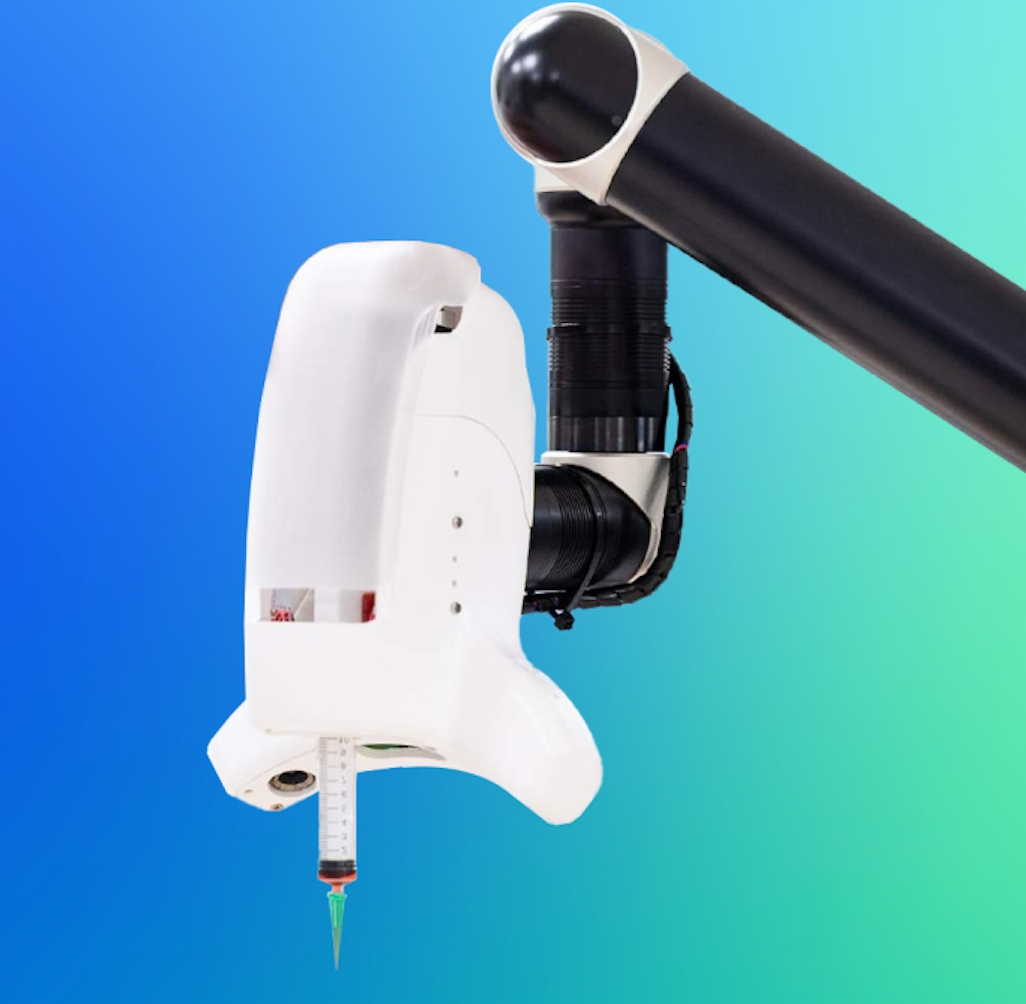Catalog

SIMEKS
27 products
View:
Telephone number:
E-mail:
simex@simex-ftir.ru
Website: http://www.simex-ftir.ru
Address:
Russia, Novosibirsk, 3/1, 709-717
Website: http://www.simex-ftir.ru
Address:
Russia, Novosibirsk, 3/1, 709-717
- Selected: 0Applying
- Selected: 0Names
- Selected: 0Manufacturer
- Selected: 0Made in
- Selected: 0Additional
View:
26 products
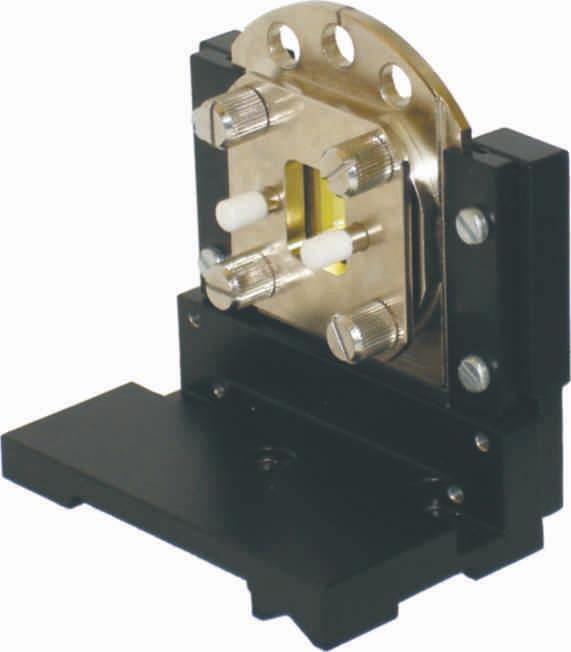
Liquid collapsible cuvettes
They are used for the study of liquids, including solutions with low concentrations
• Have a collapsible design that allows you to use the supplied gaskets of different thicknesses
• Window material – ZnSe (it is possible to order windows from SiO2 and KBr)
• Gasket material – Teflon (fluoroplast)
• Thickness of gaskets – 0.022 mm, 0.1 mm, etc.
SIMEKS
Novosibirsk
Produced in: Novosibirsk
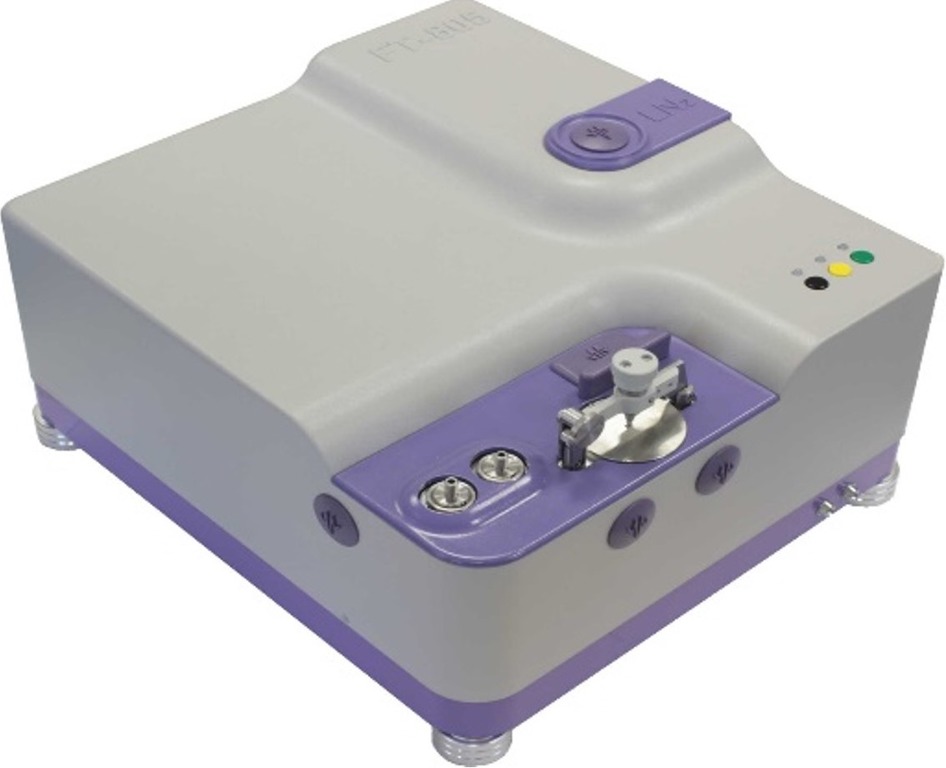
FT-805 IR Fourier spectrometer
A small-sized IR Fourier spectrometer with integrated set-top boxes and two detectors, including a highly sensitive cooled MST. Operating modes: transmission and reflection, NIP, measurements using fiber-optic probes (possible versions with one or two pairs of built-in connectors). It is possible to connect an IR microscope, a telescope to register the spectra of external radiation. The spectrometer can be used as a portable one, and is used, among other things, for express monitoring of technological processes, quality control of liquids in tanks and pipelines, during in-line analyses of biological objects, remote gas analysis.
The installation is designed to create high-quality images on various materials and provides the production of rubber cliche seals and stamps with a resolution of at least 1800 dpi.
Description
It was created on the basis of the innovative Shtrik platform, which is based on a unique control system, the hardware and software of which are entirely developed by specialists of our company.
The installation is designed to create high-quality images on materials such as rubber, metal, plastic and provides the production of cliche seals and stamps with a resolution of at least 1800 dpi.
The fiber laser used in the installation in combination with a system of galvanometric scanners ensures high quality engraving in static mode, does not require water cooling and special maintenance.
When assembling the system, only tested and certified parts are used, which guarantees an especially long service life without additional investments.
Features:
A two-coordinate high-precision positioning system for samples, with the help of which the object table is moved along the X, Y axes. As a result of the positioning system and sequential engraving of image fragments, it is possible to process with high accuracy workpieces with dimensions up to 200 × 300 mm in automatic mode according to the processing program set by the operator;
The algorithm of automatic layer-by-layer engraving using a high-precision mechanism for moving the scanning head along the Z-coordinate allows you to form highly detailed 3D images up to 5 mm deep in metal workpieces (steel, brass, aluminum, titanium, etc.);
A long process of layer-by-layer engraving of deep 3D images (possibly tens of hours) is provided without operator involvement thanks to an automatic algorithm;
The installation is equipped with a built-in system for removing combustion products from the laser radiation exposure zone, as a result of which, the absence of odors and protection of the scanning lens from the products of production is ensured, which is especially important when engraving rubber and plastics;
The installation body completely covers the processing and propagation zones of laser radiation, and the engraving is performed according to the program set by the operator in automatic mode with the installation covers closed. This design of the installation allows it to be attributed to laser devices of hazard class 1.
SIMEKS
Novosibirsk
Produced in: Novosibirsk
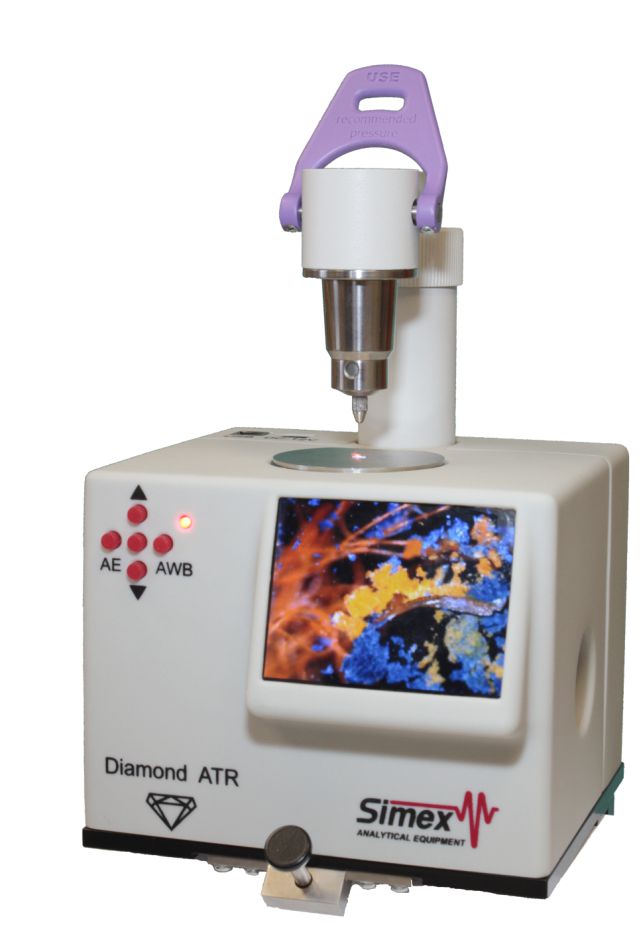
Universal set-top box of NPVO and ZDO with a diamond element and a built-in mini-monitor
It is designed for measurement by the method of disturbed total internal reflection with simultaneous visualization of a micro-object on an integrated and external monitor, as well as by the method of mirror-diffuse reflection with an angle of incidence of 45o at the upper location of the sample.
The prefix in the mode of a single NIP is used to register absorption spectra:
liquids of any degree of viscosity (solutions, suspensions, oils, etc.), including those with high chemical activity;
solid objects of arbitrary shape, including samples with very high hardness (any polymers, fragments of paint coatings, etc.);
powdery substances, including powders with very high hardness (drugs, pharmaceuticals, explosives, inorganic compounds);
samples in the form of thin tapes;
samples in the form of fibers.
The maximum hardness and chemical resistance of the diamond significantly expand the possibilities of the method; there is no need for periodic replacement of the crystal.
The set-top box allows you to register spectra without time–consuming sample preparation, and the presence of a visual inspection system of the studied surface with a high-quality video camera and a built-in high-definition mini-monitor increases efficiency when working with small samples - fragments of thin fibers, microparticles, etc. The built-in monitor has the functions of digital 10X zoom, inverting, etc. The image can be simultaneously displayed on the computer screen (using a USB interface) and then saved as a file.
The removable flange provides a quick and convenient sample change and cleaning of the crystal surface. The design with a diamond element protruding above the base plane of the NPVO allows you to study samples with sufficiently large overall dimensions.
The high quality and repeatability of the results is achieved due to the absence of the influence of the thickness of the substance layer on the shape of the spectrum and the intensity of the absorption bands.
The sample retains its original physicochemical properties and, if necessary, can be further investigated by other methods.
The universal attachment clamp is equipped with a precision lever mechanism for quickly lowering the tip and a micrometer screw that allows you to pre–set the optimal degree of pressure - this ensures quick sample change and repeatability of the results during measurements. For convenience when working with liquid and paste-like samples, as well as in the ZDO mode, it is possible to rotate the clamping console by 180o. The console is equipped with two replaceable tips – with a spherical working part and with a flat hinged head. The high hardness of the diamond allows the use of large clamping forces, which is the determining factor for obtaining high-quality spectra. A replacement table is used to register the specular and diffuse reflection spectra. The sample is located on the subject plane of the investigated surface downwards. The method is used to determine the spectral characteristics of optical parts, thin tapes on the surface, crystals, and other large solid objects of arbitrary shape and size.
SIMEKS
Novosibirsk
Produced in: Novosibirsk
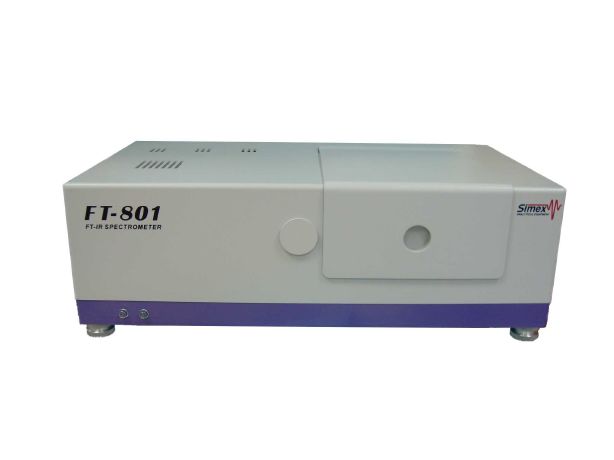
FT-801 IR Fourier spectrometer
It is designed for recording absorption spectra of solid, liquid and gaseous substances in the near and middle IR region (including drugs, lacquers and paints, petroleum products, explosives, pharmacological preparations, polymer films and fibers) with their subsequent identification, as well as for qualitative and quantitative analysis of mixtures containing several components.
SIMEKS
Novosibirsk
Produced in: Novosibirsk
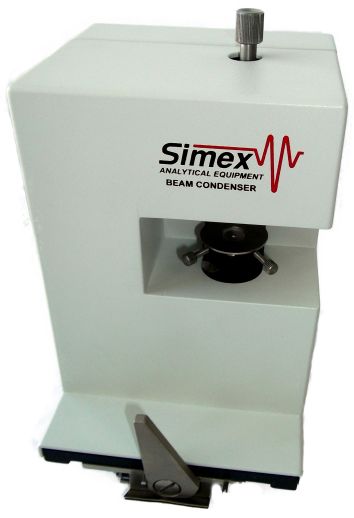
Focusing prefix MKF-Yu
It allows recording transmission spectra of objects with sizes from 500 microns (precious stones, optical parts, semiconductor materials).
It is also used in the study of samples compressed into small-diameter tablets with KBr (the method is convenient for spectral analysis of powdery substances - the prefix allows you to work with small amounts of the sample using a manual press for the manufacture of tablets).
• The diameter of the focus spot is less than 3 mm
• The design uses parabolic mirror optics
• The set-top box is equipped with a set of replaceable diaphragm holders for samples of different sizes
• Windows-substrates made of IR-transparent materials can be placed in the holder after pasty, liquid substances or extracts are applied to them, followed by drying of the layers
• The slide table has the possibility of smooth movement in vertical and horizontal directions to achieve the maximum signal level
SIMEKS
Novosibirsk
Produced in: Novosibirsk
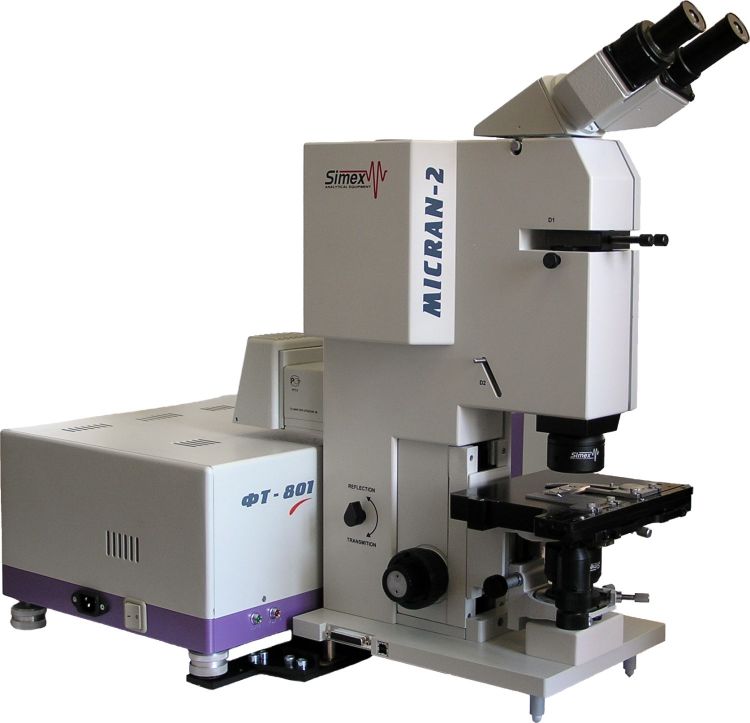
Spectral measuring complex: automated IR Fourier spectrometer "FT-801" with IR microscope "MIKRAN-2"
2 supp.
from
100 500 ₽
The wide-range IR microscope of the MICRAN series, connected to the FT-801 and Infralum FT-801 Fourier spectrometers, is designed to study samples from 10 microns in size, including heterogeneous in composition. When working on an IR microscope, the operator has the opportunity to observe the object under study with a magnification of over 200X both using binoculars and on a monitor using a digital video camera, during photometry, select a local area of arbitrary shape with the help of diaphragms, and also “scan” the surface of the sample, observing the spectrum obtained in real time.
SIMEKS
Novosibirsk
Produced in: Novosibirsk

Universal optical set-top box with zinc selenide element and integrated visualization system on an external monitor
It is intended for express analysis of various types of solid and liquid samples, including polymer particles, films and fibers, powdery substances, fragments of paint coatings, fuels and lubricants. The presence of an optical system for visual inspection of the surface under study with an increase of 75X ensures high efficiency when working with small samples – fragments of thin fibers, microparticles, etc. The universal clamp is equipped with a precision lever mechanism for quickly lowering the tip and a micrometer screw that allows you to pre–set the optimal degree of pressure - this ensures quick sample change and repeatability of the results during measurements. For convenience when working with liquid and paste-like samples, as well as in the ZDO mode, it is possible to rotate the clamping console by 180o. The console is equipped with two replaceable tips – with a spherical working part and with a flat hinged head.
A replacement table is used to register the specular and diffuse reflection spectra. The sample is located on the subject plane of the investigated surface downwards, the angle of incidence of the central beam on the sample is 45 °. The method is used to determine the spectral characteristics of optical parts, crystals, thin films on the surface, as well as to register the absorption spectra of large solid objects.
Transmission in the operating range of the spectrum, % of the input signal at least 30
The recommended number of scans when registering spectra is 25
Spectrum registration time at 25 scans (resolution 4 cm-1), sec 30
The depth of penetration of radiation into the sample, microns 5 – 15
Minimum area of a solid sample, mm 0.2 × 0.2
Minimum volume of the liquid under study, ml 1
Minimum dimensions of the fiber sample: cross-section diameter/length, mm 0.1/1
Substrate crystal material ZnSe CVD, Ge
Focusing spot diameter, mm 1
The angle of incidence of radiation (central beam) on the sample in the ZDO mode 45o
Magnification of the micro lens / total magnification of the visual channel 4X /75X
Field of view of the optical system, mm 2 X 2.5
Digital video camera resolution 640 X 480
Overall dimensions, mm 150×150×260
Weight, kg 2.15
• Allows you to study objects of small size (from 200 microns - depending on the geometry, surface quality and physico-chemical properties of the material)
• The attachment allows you to work without sample preparation, has a fixed adjustment of the pressure on the sample using a clamp equipped with color indicators
• Thanks to the removable flange with the NPVO element, a quick and convenient sample change and cleaning of the crystal surface is provided
• At a given optimal contact force, the method provides high quality and repeatability of results due to the absence of influence of the thickness of the substance layer on the shape of the spectrum and the intensity of the absorption bands
• The sample retains its original physical and chemical properties and, if necessary, can be further investigated by other methods
SIMEKS
Novosibirsk
Produced in: Novosibirsk
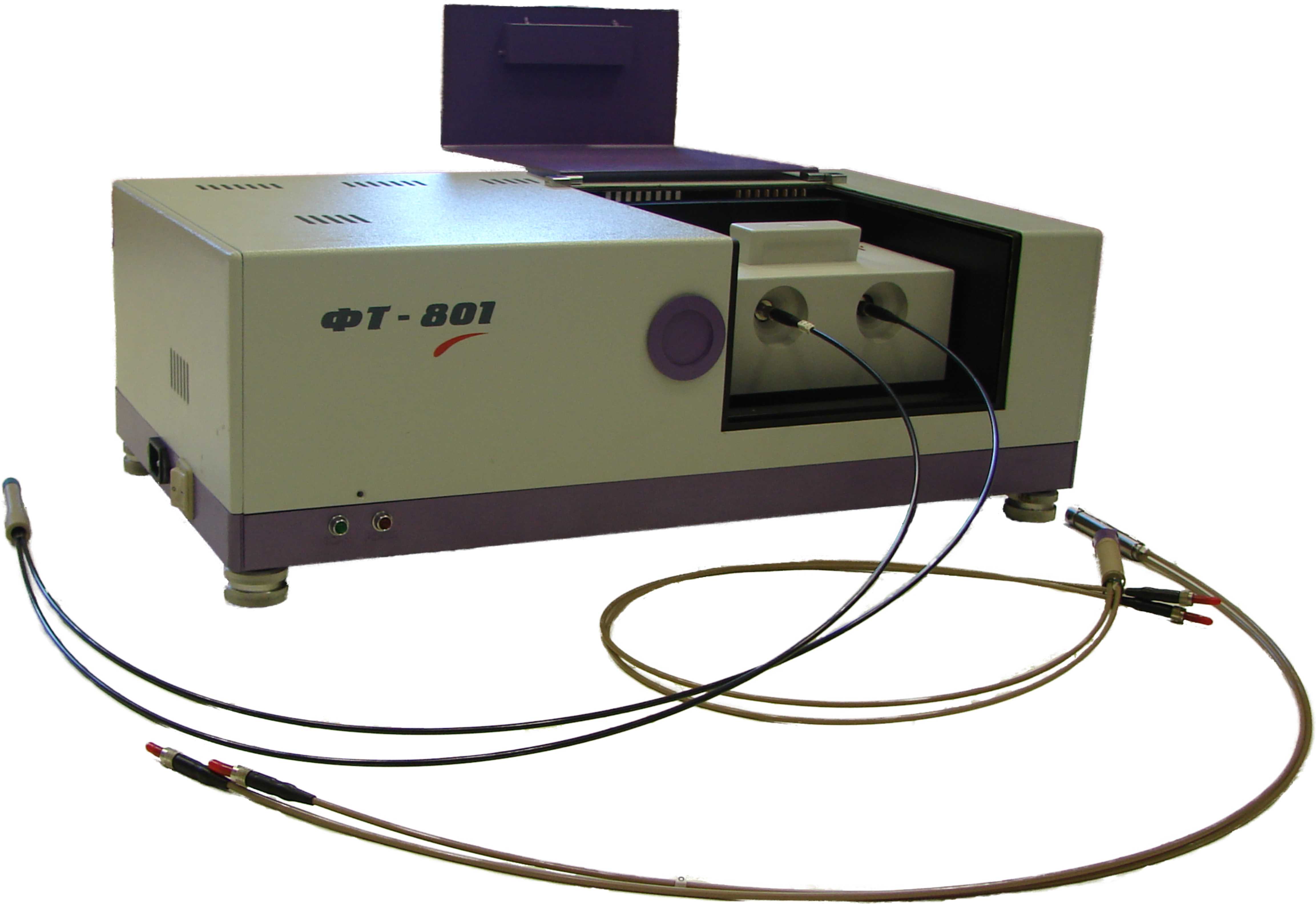
Optical set-top box for working with light-guide IR probes
FT-801 IR Fourier spectrometers can additionally be equipped with a special optical set-top box that allows efficient use of light-guide systems.
4 types of light-guide probes allow measuring transmission and reflection spectra in solid, liquid and gaseous media
Modern IR light guides have high intrinsic transmittance and sufficient mechanical strength, which makes it possible to transfer measurements from the laboratory directly to production - to control the flow of technological processes, check the quality of raw materials and finished products.
Application areas:
· Chemical and microbiological industry
· Pharmaceutical industry
· Medicine and Cosmetology
· Food industry
· Petroleum products, fuels and lubricants
· Criminology
SIMEKS
Novosibirsk
Produced in: Novosibirsk
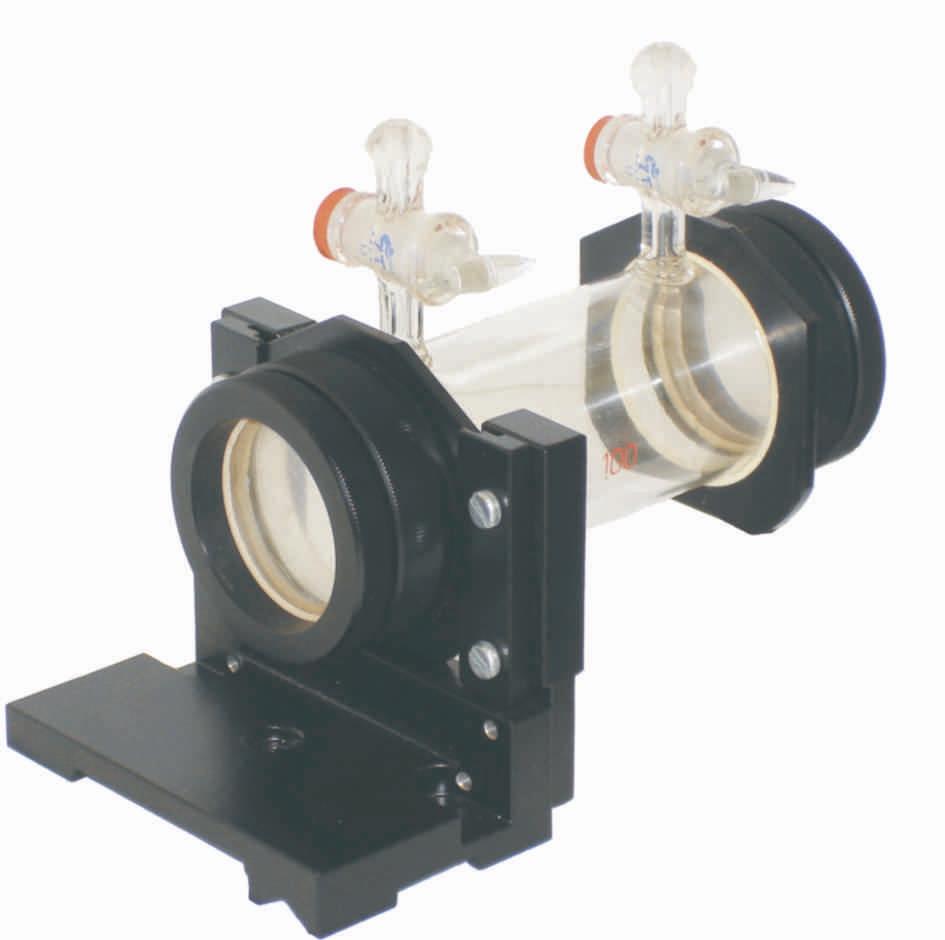
Single- and multi-pass gas cuvettes
Single- and multi-pass flask are used for qualitative and quantitative spectral analysis of gas mixtures. The use of multi-pass flask makes it possible to confidently detect extremely small concentrations of the components of the gas under study (less than ppm units).
• Three types of flask are supplied:
1. single-pass, having a stroke length of 100 mm, with a glass body and windows made of ZnSe, KBr, NaCl
2. multi-pass, with a beam stroke length of up to several tens of meters
3. multi-pass, with a beam stroke length of up to several tens of meters, equipped with a heating system of the working chamber up to 200 ° C and a thermal controller
Multi-pass cuvettes have a transparent working chamber made of quartz glass; mirrors with a gold (99.999) coating provide a reflection coefficient in the IR region of at least 98%; additionally, cuvettes can be equipped with pressure and temperature sensors, fittings for controlling gas flow, etc.
SIMEKS
Novosibirsk
Produced in: Novosibirsk
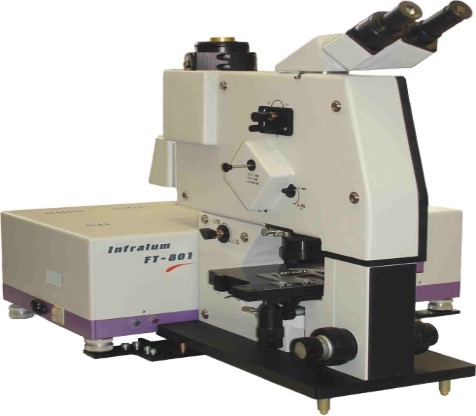
IR microscope "MIKRAN"
The IR microscope "MIKRAN" is designed to work with IR Fourier spectrometers "Infralum FT-801". The spectral range is 6000 – 600 cm-1 (with a microscope and an MST detector cooled with liquid nitrogen). Resolution 0.5, 1, 2, 4, 8 cm-1 (determined by the resolution of the Fourier spectrometer)
SIMEKS
Novosibirsk
Produced in: Novosibirsk
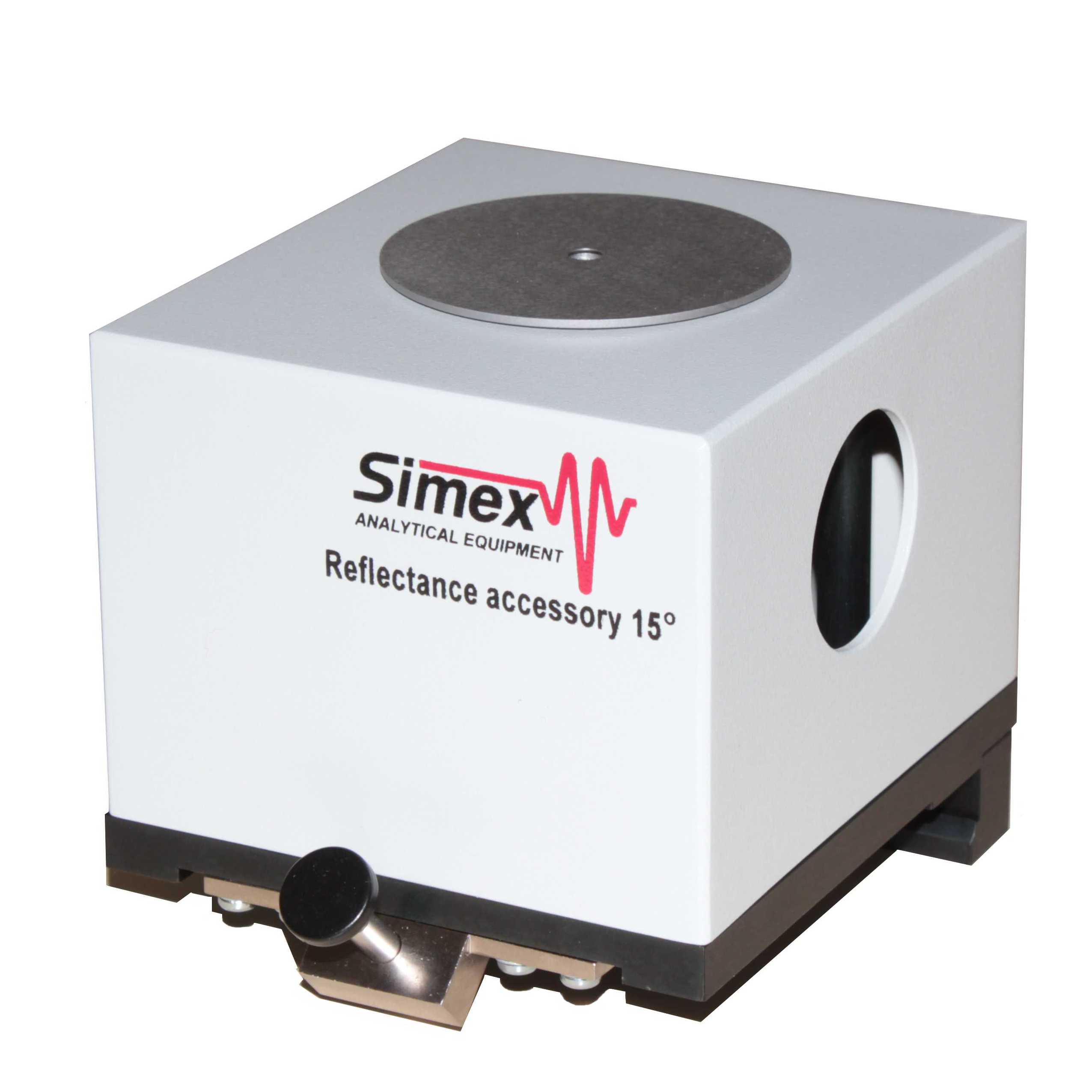
Reflection prefix PO-15 V
Designed for the study of various types of solid samples, including optical and semiconductor materials, precious stones and other objects of arbitrary shape
• The sample is located on the subject plane of the investigated surface downwards, the angle of incidence of the central beam on the sample is 15 °
• Allows you to examine samples of small sizes (the diameter of the test area is from 1 mm)
• The set-top box is equipped with a set of replaceable diaphragm holders for samples of different sizes
• When using a mini-press, it allows you to examine samples in the form of a thin layer rolled out on a mirror plate made of alloy steel (radiation passes through the substance layer twice, reflecting from the mirror surface)
• Not used: for the study of bulk and liquid substances
SIMEKS
Novosibirsk
Produced in: Novosibirsk
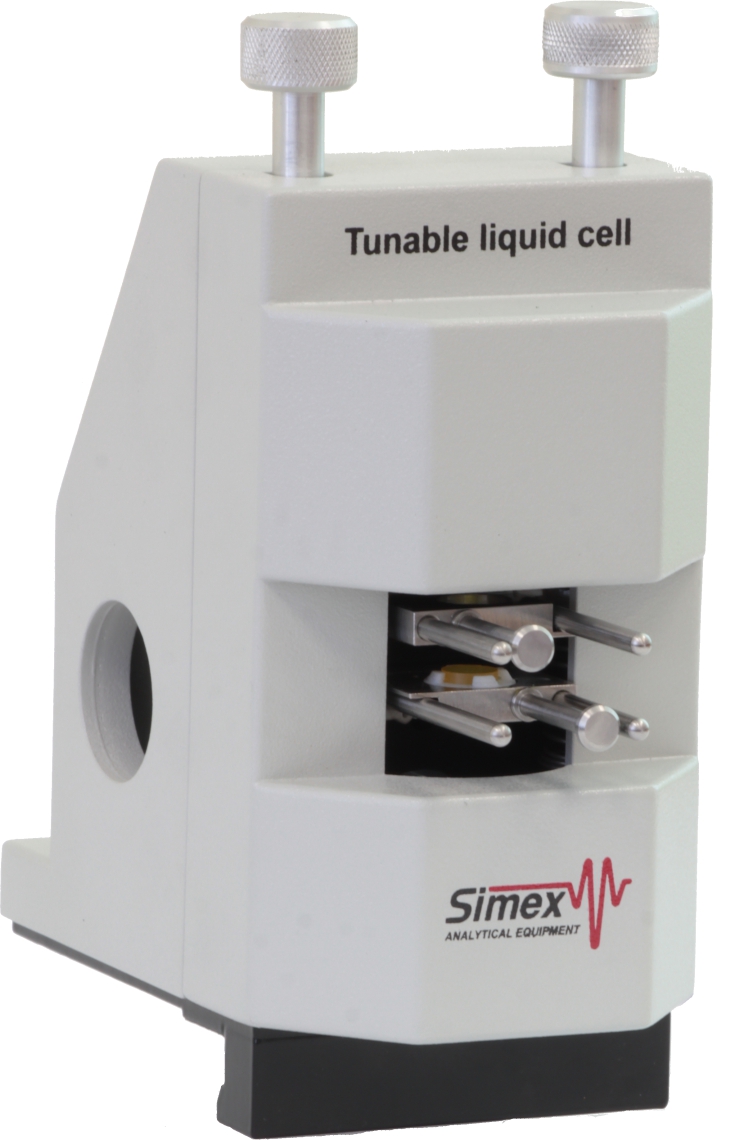
Liquid flask with adjustable thickness of the test liquid layer
A liquid flask with an adjustable layer thickness of the liquid under study is made in the form of an optical-mechanical attachment installed in the cuvette compartment of the FT-801 spectrometer. It contains focusing optics, removable holders of two windows-substrates with a diameter of 10 mm and two adjusting screws placed on the upper panel of the console housing and designed to set the required gap between the windows.
A liquid of any degree of viscosity is pre-applied in the form of a small drop to the lower window and then, in the process of smooth convergence of the windows, evenly fills the gap between them. By rotating the adjusting screws and observing the transmission spectrum online, the user has the opportunity to set the desired thickness of the liquid layer, guided by the overall intensity of the entire spectrum or by the intensity of specific absorption bands. In the presence of calibration, which is easy to create using the ZaIR 3.5 program for several samples with a known concentration, the cuvette allows quantitative measurements. The flask is indispensable in the analysis of mixtures containing impurities in small proportions.
Technical specifications
Transmission in the operating range of the spectrum, % of the input signal at least 50
The recommended number of scans when registering spectra is 16
Time of spectrum registration at 16 scans (resolution 4 cm-1), sec 20
Minimum volume of the studied liquid, mm3 1
The diameter of the focus spot, mm 3
Overall dimensions, mm 200×90×160
Weight, kg 1,1
The figure shows several spectra of the viscous lubricant "Buxol", illustrating the process of selecting the thickness of the sample layer between the windows.
The measurement process has a high expressiveness and reproducibility, inexpensive replaceable substrate windows are used, the system is easy to configure and clean, a very small amount of sample is required to obtain high-quality spectra.
SIMEKS
Novosibirsk
Produced in: Novosibirsk
